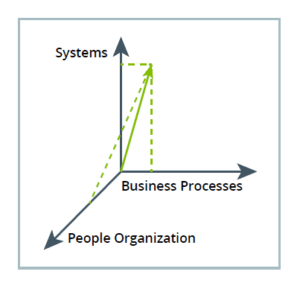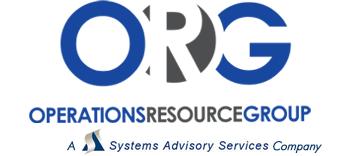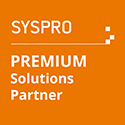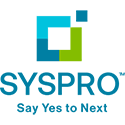Executive Guide to ERP Part 4
(originally posted to SYSPRO.com) Johan Du Toit | August 12, 2021 | Reading Time: 8 minutes

Part of the process of selecting an ERP system is to appreciate how the software is going to be used. In Part 2, I discussed the ‘Dimensions of Change Model’, a method of how to think about the process, system and structural changes that an organization will go as a result of an ERP implementation. In Part 3, the process and steps for selecting an ERP were covered – the role players, and the issues of best practice and customization. The Dimensions of Change model also comes into the selection process – that is what will be addressed now. To recap, in the Dimensions of Change [Executive Guide Part 2] we use the term ‘degrees of freedom’ to define the dimensions in which a system can move. For an enterprise, those dimensions are the IT systems, the business processes, and the organizational structure. An ERP implementation will involve a system change at least (the ERP solution), and may also include one or both of the other dimensions.
 |
The following strategies each need to be considered when evaluating and selecting an ERP system, with variations depending on which level of change your ERP project will encompass.
|
For a One Degree of Freedom ERP selection This type of project is about the ERP solution rather than business processes or organizational issues. The aim is to get benefits from a better system, not from better ways of working or organizing.
- Decision-making authority: Since this is primarily a technical project, someone with IT knowledge should lead the selection process. This may be the IT manager but outside assistance may be needed if ERP expertise is required.
- User participation: Just because this is an IT-oriented project does not mean it is also IT-only. To get a solution that delivers benefits to the whole enterprise, the selection team should include staff from various functions, not just technical people. The non-technical staff are there to ensure the ERP solution supports current business processes.
- Business process requirements: In this type of project the aim is to minimize any changes to existing business processes.
- Policies and guidelines: The key criteria for the selection team is for an ERP system that will fit current business processes. There may also be other criteria such as cost, availability of support, and amount of training needed.
- Structured selection process: The main benefits in this project come from the new ERP system. Any major customizations, or requirement for external applications, will have a significant negative impact on the selection of a system.
A Two Degree of Freedom (Business Process) ERP selection The reason for this type of project is to change the way the organization works, i.e., the business processes. Achieving this requires a new system. It is recommended to first design the business processes at a high level, then select an ERP system that enables those new processes. Doing the selection process this way means the important parameters, the business processes, are defined first and thereafter the ERP application must fit in.
- Decision-making authority: This is not a technical project but rather one of discontinuous change with the ERP system enabling that change. It is common practice for functional heads to sign off on the design of new high-level business processes. The executive decision-maker should play a major role. However, in most cases, this role requires more time (and probably expertise) than the executive can afford so a project manager is brought in to represent the executive.
- User participation: Obviously with this type of project, functional representatives are involved in the selection as well as IT staff. In the business process design phase, the non-technical staff determine and lead the project, perhaps guided by an external consultant. When it comes to the ERP system, then IT people can take over, with the functional personnel ensuring that the new system can support the new processes.
- Business process requirements: When redesigning business processes, both As-Is (existing) and To-Be (new) processes need to be mapped. The reason for this is to set a starting position (As-Is processes), with the To-Be processes as the goal.
- Policies and guidelines: It should be stated that enabling the new businesses processes is key, and that they will not be modified to suit an ERP system. An ERP system must verify that it can support these processes, and very little change to organizational roles will be allowed.
- Structured selection process: There are several stages to this.
- Scope the processes that will be changed.
- Identify functional process owners and give them training on processes and what is best practice.
- Evaluate whether the scoped business processes need re-design.
- Design new processes and then have the project team, and other parts of the organization, assess and decide whether to accept them or not.
- Using the short list of potential ERP providers, evaluate how the ERP solutions match the new business processes, and how much modification is needed for the software to support the processes. This stage requires in-depth and thoughtful work, and oversight by senior executives is advisable.
A Two Degree of Freedom (People-Organization) ERP selection Organizational re-structuring is the justification for this project. An ERP system is seen as the way to rationalize functions and automate tasks. Even though business process change is not intended in this project, some significant changes will be needed.
- Decision-making authority: Because this project directly affects people, it is a sensitive undertaking. Whether work is done completely in-house, or with the help of external consultants, it needs to be driven by senior executives to ensure concerns are managed.
- User participation: There is usually not much choice for the people involved in the change, but change is usually on a limited selection of an organization’s structures. Nevertheless, staff buy-in is important for this type of project to succeed.
- Business process requirements: The process of changing organizational functions will inevitably mean some business process changes. Accompanying the structural changes, To-Be business processes will need to be defined.
- Policies and guidelines: Because the project focus is on structural changes rather than process changes, policies to limit scope creep are important.
- Structured selection process: As in the previous case, there are multiple steps.
- Identify the organizational aspects to change.
- Design the new organization structure, and associated processes,
- Get the changes reviewed and approved.
- The evaluation of the ERP vendor short list should be based factors such as on task automation, quality of user interface and experience, culture-fit and capability.
A Three Degrees of Freedom ERP selection This project is rare, and potentially high risk. But it can occur when new divisions are created, or after major acquisitions and mergers.
- Decision-making authority: This project has to be led from the top and therefore should have a board-level executive full-time on the project.
- User participation: No person, function or process is exempt from change in this type of project. Communication and involvement are imperative to reduce sensitivities and ensure buy-in from staff.
- Business process requirements: The business processes developed form the blueprint for the organization, in the same way as an architect’s plan show how a house is to be built.
- Policies and guidelines: In a project like this, there will be few policy constraints and the team usually has freedom to consider many options. The major constraint is time, as the organization has to go ‘on hold’ and cannot be like that for too long. The team also has to ensure their decisions do not go against the strategies that direct this project.
- Structured selection process: In this case, the design elements (people, function, process) have to be established first. Then the selection process can begin. The evaluation of solutions can be more extensive as the issue of future-fit will be important, bearing in mind that there is also a risk because the new designs are unproven.
Moving to the next stage While each type of selection project follows five strategies, the way they are executed, the amount of work and who does it is completely different. That is why it is important to understand the ‘Degrees of Change’ model. However, if it properly applied, then at the end of the selection process the organization has an ERP system, business process blueprint and, possibly, new organizational design with which it can move forward. The next stage is how to make the change happen – the implementation project. Johan Du Toit Johan du Toit is the Strategic Sales Executive for SYSPRO Africa. He has more than 20 years’ experience in delivering complex technology and business transformation projects in Africa, Europe and the Far East. Renowned for finding practical solutions for complex problems, serving and contributing to the IT Steering Committees of a number of blue chip organizations on a continuous basis. Johan is dedicated to growing and maturing the SYSPRO Channel network.


